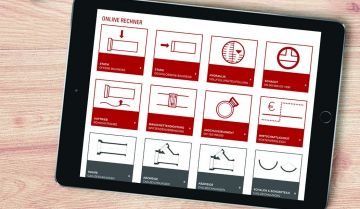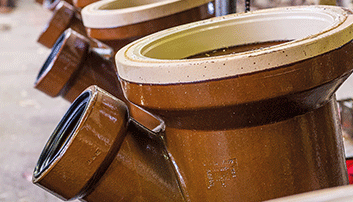Functional properties of sewage pipe joints
Fully functional joints are essential components of many different technical products. In the simplest case, the job is to seal off an only slightly aggressive medium under atmospheric pressure. In more complex applications, the system must guarantee a high degree of tightness and plant safety under high operating temperatures, high pressures and aggressive media. Seals are an indispensable factor in ensuring the proper function of the wastewater drainage system, and are located at the most sensitive places in technical systems, i.e. at the separating joints.
Angular deflection
The possibility of subsidence in the supporting area due, for instance, to mining subsidence events, groundwater flow or construction activities, should always be considered in the planning stage. Slight deflections in the angle can easily occur at the vitrified clay socket joints, which is why the tightness of the joint constitutes an important safety aspect in the case of pipe deflection. The minimum requirements are specified in EN 295 and ZP WN 295.
Displacement
According to the rules and regulations, a displacement of at least 0.5 cm must be observed to ensure that slight deflections are still possible. The assessment of the displacement in a built-in vitrified clay socket pipe is dependent on the design of the socket. The dimensions are specified in ZP WN 295.
Shear resistance
According to EN 295-3:2012, section 21.3, a pipe connection must be capable of withstanding both short-term and long-term shear loads. In the test, an external load is applied to the pipe section that results in a minimum shear load on the connection joint of at least 25 N/mm nominal size. The joint must be capable of withstanding the test pressures of 5 kPa (0.05 bar) and 50 kPa (0.5 bar) specified in EN 295-1:2013, section 6.2.1, over a period of 15 minutes without any apparent leakage. Wherever pipes and fittings are planned for continuous operation under slight pressure overload, the test pressure must be specified. A component may be tested in one joint assembly only. Joint assemblies that pass this test are also approved as resistant to root penetration.
Continuity of invert
The continuity of invert describes the point of transition from one pipe to the next at the joint assembly in the area of the invert. To ensure the optimal hydraulic performance capacity of the installed pipe system, specific limits for each nominal size are defined in EN 295. With regard to the various joint systems, the instructions given in the installation manuals of the respective manufacturer must be followed to ensure the continuity of invert during the installation of the pipes.
Resistance to root penetration
Vitrified clay pipes and fittings are resistant to root penetration; the resistance to root penetration is demonstrated in conjunction with the shear load test. The corresponding requirements are defined in EN 295-3.



